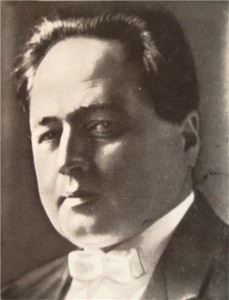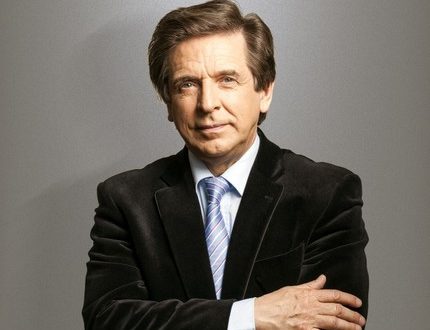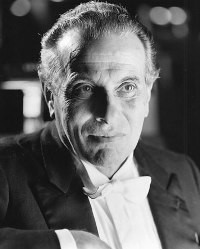
Alexander Vasilyevich Gauk |
Alexander Gauk

People’s Artist of the RSFSR (1954). In 1917 he graduated from the Petrograd Conservatory, where he studied piano by E. P. Daugovet, compositions by V. P. Kalafati, J. Vitol, and conducting by N. N. Cherepnin. Then he became the conductor of the Petrograd Theater of Musical Drama. In 1920-31 he was a conductor at the Leningrad Opera and Ballet Theatre, where he mainly conducted ballets (Glazunov’s The Four Seasons, Stravinsky’s Pulcinella, Gliere’s The Red Poppy, etc.). He performed as a symphony conductor. In 1930-33 he was chief conductor of the Leningrad Philharmonic, in 1936-41 – of the State Symphony Orchestra of the USSR, in 1933-36 conductor, in 1953-62 chief conductor and artistic director of the Bolshoi Symphony Orchestra of the All-Union Radio.
Monumental works occupied a special place in Gauk’s varied repertoire. Under his direction, a number of works by D. D. Shostakovich, N. Ya. Myaskovsky, A. I. Khachaturian, Yu. A. Shaporin and other Soviet composers were first performed. The pedagogical activity of Gauk played an important role in the development of the Soviet conductor’s art. In 1927-33 and 1946-48 he taught at the Leningrad Conservatory, in 1941-43 at the Tbilisi Conservatory, in 1939-63 at the Moscow Conservatory, and since 1948 he has been a professor. Gauk’s students include E. A. Mravinsky, A. Sh. Melik-Pashaev, K. A. Simeonov, E. P. Grikurov, E. F. Svetlanov, N. S. Rabinovich, E. S. Mikeladze, and others.
Author of a symphony, symphonietta for string orchestra, overture, concertos with orchestra (for harp, piano), romances and other works. He instrumented the opera The Marriage by Mussorgsky (1917), The Seasons and 2 cycles of Tchaikovsky’s romances (1942), etc. He restored Rachmaninov’s 1st symphony using the surviving orchestral voices. Chapters from the memoirs of Gauk were published in the collection “The Mastery of the Performing Artist”, M., 1972.
“The dream of conducting has been in my possession since the age of three,” Gauck wrote in his memoirs. And from a young age, he consistently strived to realize this dream. At the St. Petersburg Conservatory, Gauk studied piano with F. Blumenfeld, then studied composition with V. Kalafati, I. Vitol and A. Glazunov, mastered the art of conducting under the guidance of N. Cherepnin.
After graduating from the conservatory in the year of the Great October Revolution, Gauk began his career as an accompanist at the Musical Drama Theatre. And just a few days after the victory of Soviet power, he first stood at the podium to make his debut in an opera performance. On November 1 (according to the old style) Tchaikovsky’s “Cherevichki” were performed.
Gauk became one of the first musicians who decided to give his talent to the service of the people. During the harsh years of the civil war, he performed in front of the soldiers of the Red Army as part of an artistic brigade, and in the mid-twenties, together with the Leningrad Philharmonic Orchestra, he traveled to Svirstroy, Pavlovsk and Sestroretsk. Thus, the treasures of world culture were opened before a new audience.
An important role in the creative development of the artist was played by the years when he led the Leningrad Philharmonic Orchestra (1931-1533). Gauk called this team “his teacher.” But here mutual enrichment took place – Gauk has an important merit in improving the orchestra, which later won world fame. Almost simultaneously, the theatrical activity of the musician developed. As the chief ballet conductor of the Opera and Ballet Theater (former Mariinsky), among other works, he presented the audience with samples of young Soviet choreography – V. Deshevov’s “Red Whirlwind” (1924), “The Golden Age” (1930) and “Bolt” (1931) D. Shostakovich.
In 1933, Gauk moved to Moscow and until 1936 worked as the chief conductor of the All-Union Radio. His ties with Soviet composers are further strengthened. “In those years,” he writes, “a very exciting, ebullient and fruitful period in the history of Soviet music began … Nikolai Yakovlevich Myaskovsky played a special role in musical life … I had to often meet with Nikolai Yakovlevich, I lovingly conducted most of the symphonies he wrote.”
And in the future, having headed the State Symphony Orchestra of the USSR (1936-1941), Gauk, along with classical music, often includes compositions by Soviet authors in his programs. He is entrusted with the first performance of his works by S. Prokofiev, N. Myaskovsky, A. Khachaturyata, Yu. Shaporin, V. Muradeli and others. In the music of the past, Gauk often turned to works that, for one reason or another, were ignored by conductors. He successfully staged the monumental creations of the classics: the oratorio “Samson” by Handel, Bach’s Mass in B minor, “Requiem”, the Funeral and Triumphal Symphony, “Harold in Italy”, “Romeo and Julia” by Berlioz …
Since 1953, Gauk has been artistic director and chief conductor of the Grand Symphony Orchestra of the All-Union Radio and Television. In working with this team, he achieved excellent results, as evidenced by the numerous recordings made under his management. Describing the creative manner of his colleague, A. Melik-Pashayev wrote: “His conducting style is characterized by external restraint with incessant internal burning, maximum exactingness at rehearsals under conditions of full emotional “load”. Oi invested in the preparation of the program all his passion as an artist, all his knowledge, all his pedagogical gift, and at the concert, as if admiring the result of his labors, he tirelessly supported the fire of performing enthusiasm in the orchestra artists, kindled by him. And one more remarkable feature in his artistic appearance: when repeating, do not copy yourself, but try to read the work “with different eyes”, embody a new perception in a more mature and masterful interpretation, as if transposing feelings and thoughts into a different, more subtle performing key.
Professor Gauk brought up a whole galaxy of major Soviet conductors. At various times he taught at the Leningrad (1927-1933), Tbilisi (1941-1943) and Moscow (since 1948) conservatories. Among his students are A. Melik-Pashaev, E. Mravinsky, M. Tavrizian, E. Mikeladze, E. Svetlanov, N. Rabinovich, O. Dimitriadi, K. Simeonov, E. Grikurov and others.
L. Grigoriev, J. Platek, 1969





